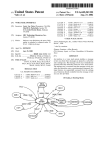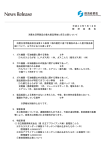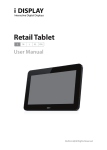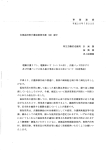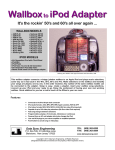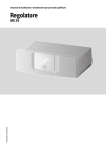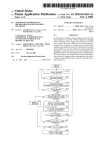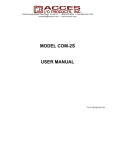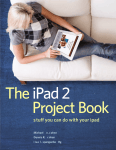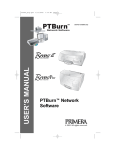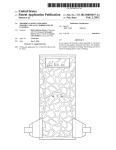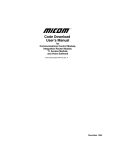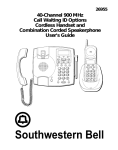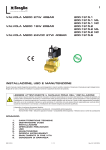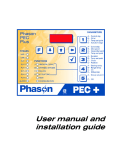Download Voice mail interface
Transcript
US 20020191753A1 (19) United States (12) Patent Application Publication (10) Pub. No.: US 2002/0191753 A1 (43) Pub. Date: Valco et al. Dec. 19, 2002 Related US. Application Data (54) VOICE MAIL INTERFACE (63) (75) Inventors: Larry Lee Valco, Pleasanton, CA (US); Continuation of application No. 09/558,292, ?led on Apr. 25, 2000, noW Pat. No. 6,442,243. Sherrill J. Packebush, Austin, TX (US); John Payton Beans, Oakland, Publication Classi?cation CA (US) Correspondence Address: GREENBLUM & BERNSTEIN, P.L.C. 1941 ROLAND CLARKE PLACE (51) Int. Cl? .................................................... ..H04M 1/64 (52) Us. 01. .......................................................... .. 379/671 (57) RESTON, VA 20191 (US) ABSTRACT A method for interfacing a subscriber to a voice mail component of a telecommunications system is provided. The method includes playing messages to the subscriber When (73) Assignee: SBC TECHNOLOGY RESOURCES, INC., Austin, TX (US) (21) Appl. No.: the subscriber is in a message revieW area and providing a 10/166,654 plurality of functions to the subscriber While the messages are playing and including an option of accessing a settings area. The method further includes placing the subscriber in Jun. 12, 2002 sequentially listing a series of persistent settings features When the subscriber is in the settings area. a settings area in response to a subscriber’s command and (22) Filed: EMAlL CALL I REVIEW : 66 55 * DONE * TIME 4 DONE’ :HME i .. _ D0NE,*,TIME ‘ O . SETTlNGS AREA DONE,*,TIME " \ 6 5 DONE,*,T1ME ENVELOPE > . Patent Application Publication Dec. 19, 2002 Sheet 1 0f 2 ZOFUDMELmH US 2002/0191753 A1 Eng/EA H.UE 5NEH2/i Patent Application Publication Dec. 19, 2002 Sheet 2 0f 2 QEFwnmZ*Q2O?Q 0. @*ZOQaA m2?. .UEm méa%zca mm 3 *?nmzit A130 mEFwZOQ US 2002/0191753 A1 Dec. 19, 2002 US 2002/0191753 A1 VOICE MAIL INTERFACE CROSS-REFERENCE TO RELATED APPLICATION [0001] This application is a continuation of US. patent application Ser. No. 09/558,292, Which Was ?led Apr. 25, 2000, the content of Which is incorporated herein in its entirety. BACKGROUND OF THE INVENTION [0002] 1. Field of the Invention [0003] The present invention relates to the ?eld of tele communications. More particularly, the present invention used, it is often forgotten or thought to not exist. As a result, most users eventually learn hoW to change their greeting, and little else. [0009] Conventional voice mail interfaces are also saddled With draWbacks When adding a neW setting. In order to add a neW setting, several decisions are required. First, the location in the decision tree must be selected. Second, hoW to restructure neW and existing features to attempt to main tain consistency must be determined. Third, hoW to inform subscribers of the neW setting must be decided. That is, the basic architecture of the service must be redesigned When adding neW features to the service. [0010] The Message Center, a voice mail system available relates to a voice mail interface having a non-hierarchical interface structure that permits a user to access voice mail from Paci?c Bell Telephone Co., is a conventional menu driven voice mail program. As With all conventional voice mail interfaces, the user must develop a basic mental map features Without having to memorize commands. before being able to easily navigate from state to state. The [0004] 2. Background Information [0005] When a user subscribing to a voice mail service accesses a voice mail system, (for example, to listen to a recorded message), the user interacts With a voice mail interface. Typically, the user enters a passWord to access a voice mailbox and then enters a command (for example, presses a key on the telephone touchpad) to play a message or to enter a settings area. [0006] Traditional settings areas rely heavily on menus. To change a setting, the user “navigates” to the appropriate area and modi?es the setting. The user then “navigates” back to other functions. As seen in FIG. 1, conventional placement of functions and settings in tree-like menus requires that the user be in the right place at the right time to perform any function. For example, the user accesses a main menu after calling into the system and being validated. From the main menu, the user can access various states/settings areas by pressing 1 to revieW messages, 2 to send a message, 3 to access a personal pro?le, 4 to set greetings, 5 to access a groups function, or 11 to scan, i.e., revieW envelope infor mation for all messages. To return from each state to the previous state, the user presses the * key. Thus, in order to return to the main menu from replying to a message, the user presses the * key tWice, once to return to the message revieW typical user Will invent and share “shortcuts” that alloW a function in one state to be immediately accessed from another state. An example is using 3-3-7 to erase a message. This shortcut spans tWo major program states: message listening, in Which 3-3 means “go to the end” and 7 means “reduce volume”; and message disposition after the message has played, in Which 7 means “erase.” Notice in the midst of 3-3-7 that the 7 key changes meaning. A user must under stand that just pressing 7 during a message Will not erase it and that the user must ?rst go to the menu that folloWs the message and then erase the message. [0011] It is more user friendly to alloW any command to be issued at any time (Where practical). The Message Center and CallNotes, a voice mail system available from South Western Bell Telephone Co., took a step in this direction by collapsing message listening and message disposition into a single state (you can erase a message during and after a message). HoWever, a system is still needed to take this approach further. That is, a system is desired that reduces the number of states or modes of the application, gives promi nence to commonly used functions, at the expense of less used or advanced-user functions, and is as similar as pos sible to the current interface. [0012] It is knoWn that only about ten percent of voice area (after ?nishing the reply), and once to return from the mail users Will look at the user’s manual. It is also knoWn that calls to customer service are a signi?cant expense. But message revieW area to the main menu. perhaps the most expensive consequence of complex voice [0007] As can be seen, users often have to go up and doWn the typical voice mail options tree structure to ?nd a desired function. For example, if a user revieWing messages Would like to set a passWord, the user must press the * key to leave customer satisfaction, retention, and Word-of-mouth refer rals. message revieW, press the 3 key to enter the personal pro?le face of voice mail systems. Accordingly, the present inven area, and ?nally press the 1 key to access the set passWord tion attempts to make every function or feature available at mail interfaces is the effect that frustration can have on [0013] Therefore, a need exists to simplify the user inter area. Similarly, the user cannot send a neW message While all times in order to reduce the amount of learning and revieWing messages. Instead the user must leave message customer support time required, and to increase day-to-day revieW and return to the main menu. user satisfaction. [0008] Another disadvantage of conventional menu driven interfaces is that, due to the tree type structure and hierar BRIEF DESCRIPTION OF THE DRAWINGS chical nature of the options menus, many features are nested [0014] The present invention is further described in the detailed description that folloWs, by reference to the noted Within menus and are therefore not used or understood by the majority of users. Consequently, users avoid or have trouble changing the settings of their mailboxes. Further, the tree type structure makes ?nding options and navigating dif?cult, to the point Where unless the option is frequently draWings by Way of non-limiting examples of preferred embodiments of the present invention, in Which like refer ence numerals represent similar parts throughout several vieWs of the draWings, and in Which: Dec. 19, 2002 US 2002/0191753 A1 [0015] FIG. 1 shows a state diagram of a conventional voice mail interface; and [0016] FIG. 2 shows a state diagram of a voice mail interface, in accordance With an aspect of the present inven tion. DETAILED DESCRIPTION OF THE PREFERRED EMBODIMENTS a previous settings feature When receiving a repeat com mand from the subscriber. When the subscriber enters a return command during the sequential listing of settings features, the subscriber is returned to the message revieW area. [0022] In one embodiment, changing one of the settings features includes immediately returning to the message revieW area after the settings feature has been changed. In addition, the series of settings features are listed in a [0017] In vieW of the foregoing, the present invention is directed to simplifying the user interface to voice mail prioritiZed order With a greetings settings feature being ?rst. Changing one of the settings features involves sequentially systems. The present invention includes a ?at, non-modal, non-hierarchical interface structure. Whenever possible, the amount of “navigation” required has been eliminated or kept to a minimum. That is, all options and settings or placed in a single location: the Settings Area. [0023] According to another aspect of the present inven [0018] An object of the present invention is to provide an face includes a message revieW area from Where messages are played to a subscriber, and a settings area. The message easy to learn and convenient to use interface to a voice mail system. In order to achieve this object, the interface does not include a main menu, reducing navigation throughout the interface. More speci?cally, the user can press a predeter mined key (e.g., “0”) to enter a special Settings Area. Once in the Settings Area, the system presents options that the user listing parameters for changing the settings feature. tion, an interface to a voice mail system embodied on a computer readable storage medium is provided. The inter revieW area is immediately accessed When the subscriber enters the voice mail system. The settings area is accessed from the message revieW area When the subscriber enters a predetermined command. Multiple settings features are sequentially accessed from the settings area; and multiple functions are directly available from the message revieW can select. When an option is selected, the user can set the area. In one embodiment, the message revieW area plays a desired preference for that option. Thus, the user need only learn the predetermined key and the system Will then guide subsequent message a predetermined time period after a current message ?nishes playing, in the event that the the user through the process. According to another aspect of subscriber does not enter a command. the present invention, more experienced users can press a second predetermined key (e.g., the pound key) to quickly skip to the setting the user needs. After completing the setting, the user is returned to message revieW. Alternatively, a third predetermined key (e.g., the star key) can cancel an action and immediately return the user to message revieW. [0019] According to an aspect of the present invention, a method is provided for interfacing a subscriber to a voice mail system. The method includes immediately placing the subscriber in a message revieW area When the subscriber enters the voice mail system and playing messages to the subscriber. The method also includes providing multiple functions to the subscriber, Which are available While the messages are playing. The method further includes placing the subscriber in a settings area in response to a subscriber’s [0024] A number of prompts associated With each settings feature are provided. A ?rst prompt is played to identify the title of each settings feature and, When the settings command has not been entered, a second prompt is played describing the settings feature. When the settings command has still not been entered, the ?rst and second prompts are played again, and When the settings command has still not been entered, a ?rst prompt associated With a neXt command is played. [0025] According to one embodiment, a neXt settings feature is skipped to upon receiving a skip command from the subscriber and a previous settings feature is repeated When receiving a repeat command from the subscriber. Furthermore, When the subscriber enters a return command, the subscriber returns to the message revieW area. settings area command, sequentially listing a series of set tings features When the subscriber is in the settings area, and [0026] According to one aspect of the invention, the changing one of the settings features in response to a of the present invention, a subsequent message is played a predetermined time period after a current message ?nishes after a settings feature has been changed. The settings features also include a greetings settings feature, Which is listed ?rst and other settings features listed in a priority order. Sequentially listed parameters can also be provided playing, in the event that the subscriber does not enter a command. for each settings feature, the parameters being for changing the settings feature. subscriber’s settings command. According to another aspect [0020] Sequentially listing a series of settings features also includes playing a prompt listing the title of each settings feature and, When the settings command has not been entered, playing a second prompt describing each settings feature. When the settings command has still not been entered, the ?rst and second prompts describing the settings feature are again played, and When the settings command has still not been entered, prompts associated With a subse quent command are played. subscriber immediately returns to the message revieW area [0027] By providing the ?at interface of the present inven tion, neW settings can be added to a list of settings and can be used immediately Without special user training. The user simply presses 0 to access the Settings Area and then either Waits or jumps to the neW setting. Thus, the menu structure need not be redesigned Whenever a neW setting is added. [0028] The present invention provides business and resi dential subscribers With access to many basic and advanced voice mail messaging capabilities. Subscribers can receive [0021] Sequentially listing a series of settings features and revieW various message types, including voice mail, faX, may also include skipping to a neXt settings feature When and email. They can reply to a received message via Live receiving a skip command from the subscriber and repeating Reply/Message Direct (i.e., the sender is called directly) or Dec. 19, 2002 US 2002/0191753 A1 With a recorded message, depending upon the availability of stamp Was not played prior to the message. This is another the sender information. They can send a copy of a received user-settable option having an on/off option. message to other subscribers and non-subscribers, provided that the received message is not marked private. They can also record messages to be sent to both subscribers and non-subscribers. Through the Settings Area, subscribers can [0033] If the user does not choose to repeat, save, erase, reply, or send a copy Within about ?ve seconds, the next message is announced and played. This “hands free” opera change various mailbox features and access additional func tion facilitates Wireless and speaker phone revieW. tionality, including: Greeting(s), PassWord(s), Erased Mes [0034] According to the present invention, there is no sages, Transfer to Pager, Caller Transfer, Phone Search, Distribution Lists, Recorded Name, Time and Date Stamp, NeW Message Noti?cation, Phone Number Nicknames, and “main menu,” rather messages begin playing automatically. Helpful Hints. Subscribers can also have extension mail boxes, With one group greeting and individual extension greetings. Other features are of course contemplated by the present invention. In terms of overall style, the prompts are brief and direct, alloWing focus on the messages themselves, and making the interface feel as “light,” unobtrusive, and forgiving as possible. [0029] According to one embodiment of the present inven tion, When the user calls in to check messages for the ?rst time, the voice mail system: presents a brief thanks, an If a user Wants to send a neW message, access email, or change a setting, the user may request to do so at virtually any time. Although a number of current voice mail systems have a system option to begin playing messages immedi ately, these systems typically retain the main menu func tionality but skip over it upon mailbox access. Consequently, navigation back to the main menu is still required to send a message or change a setting. [0035] Messages are classi?ed as “new” or “saved.” NeW messages are played ?rst, then saved messages, then the cycle repeats. A message remains neW until the user explic introduction about What is going to happen, hoW long it Will itly saves or erases it. Messages marked as urgent ?oat to the top of each queue. Saved messages are aged off after a take, and hoW it can be handled by the user. The system then certain period. Walks the user through steps for changing the temporary passWord, selecting/creating a greeting, and recording a name announcement. The system con?rms each step When appropriate and offers the user the option to do it over. The system also coaches the user on each feature and setting as [0036] According to one embodiment of the present inven tion, the folloWing functions are available during message revieW, the most important of Which are shoWn in FIG. 2. appropriate; and only continues to the next item When the last item has been con?rmed. The voice mail system Repeat (1) Save (2) Erase (3) resumes initialiZation on the next call if the user hangs up Reply (4) before all of the settings have been presented at least once. InitialiZation resumes Where the user left off, preventing the Copy (5) (aka. “forWard”) Send neW message (6) Jump back in a message (7) Pause message playing Jump ahead in user from having to redo any previously completed portion of the initialiZation process. The initial call ends With a quick tip on operation and a thank you, and puts the user into the user’s mailbox on that ?rst call. [0030] By far the most common activity for users is listening to neW messages, both voice and fax. If a sub scriber has multiple phone lines for one mailbox as a feature, message (9) Jump to next queue Go back to previous Go to settings area (0) Skip a message (#) message (1-1) Perform Quick Reply (4-4), Print (5-5), (if an (call a message sender Go to email (6-6) email or fax) directly) SloW doWn a message (7-7) Play time/date stamp (8-8) Speed up a message (9-9) then messages from multiple phone lines Will be available for revieW Within a single mailbox of the present invention. [0037] When the user calls to listen to messages, the messages and after a message, With a single command. In most cases, begin playing automatically. Thus, the message revieW a menu is played after each message that only prompts for replay, save, and erase. Reply and copy are included When applicable and print is included if the message is a fax or email. process is streamlined. Each message is numbered (“First neW message, second neW message”), and then the time and date that the message Was received is played (unless the user has turned off the time/date feature from the Settings Area). Exemplary prompts that a user might hear upon dialing their access number include: [0031] “You have tWo neW messages. Message one . . . ‘Hi there, it’s Alan calling at around ?ve pm. I guess you’re not home. I’ll call back later.’ To repeat The user may activate each function, both during [0038] After successfully executing “modal” commands, i.e., commands unique to an area, such as reply, copy, send, check time/date, or enter Settings Area, the user is returned to the end of the current message. If a message is skipped, saved, or erased, the system moves to the next message. The press 1, to save press 2, to erase press 3, to reply user can, hoWever, return to the previous message at any time. If the user does not enter a command Within several press 4, to send a copy press 5 . . . [?ve seconds] . seconds from the playing of the “after message” menu, the . system moves to the next message. . Message tWo . . . ” [0032] Notice that the passWord Was not requested in this example. As an option, the user may request that calls from their oWn phone are not screened With a passWord. Callers from other phones, hoWever, Would still need to enter a passWord to obtain access. This user-settable option is referred to as PassWord Skip. In this example, the time/date [0039] Some branching or “modality” (the condition of being constrained to the task at hand) cannot be eliminated. As seen in FIG. 2, Which shoWs the primary modes of the current design, the user is immediately placed in message revieW. From message revieW the other major states are all available. Dec. 19, 2002 US 2002/0191753 A1 [0040] According to an aspect of the present invention, time to dial numbers; and alloW entry of any number up to inactivity on the users’ part is a valid input, and should gracefully alloW hands-free usage and exit from any func tional modes in an appropriate manner (e.g., When listening to emails or changing a setting, “doing nothing” Will even tually lead the user back to voice messages). In addition, double keystrokes cannot be relied on for mainstream usage, and are reserved for advanced features only. To prevent a late command, e. g., a late press of the 3 key, from erasing the eleven digits long (if necessary, an extension is subsequently prompted, so it can be typed along With the number). Will noW be discussed. In order to end an address, the system folloWing message, Which is automatically played after the classify the numbers entered so far into one of three cat previous message, the erase command is applied to the previous message during the ?rst 0.5 seconds of the next message’s number prompt. Other delay periods can be set egories. The ?rst category is VALID, occurring When 7 or 10 based upon need. When: 1 to 5 digits correspond to a entry in a personal distribution list; 1 to 5 digits correspond to a valid extension; [0041] Individual features available in an exemplary implementation of the present invention are noW discussed. A reply feature, if reply information is available, can be provided and Will cause the system to ask the user if he Wishes to reply to the message Without entering the sender’s [0045] The logic and timeouts used during address entry assumes that entry is complete When one of three things happens: the pound key is depressed, the star key is depressed, or a time out occurs. As each digit is entered, the system evaluates the validity of the entry. The system Will digits are recogniZed as a subscriber, or 11 digits are entered. The second category is MIGHT BE VALID, occurring 7 digits are entered and 1 to 3 digits are not a recogniZed area code; or 5 digits have been entered and digit 1 is digit 3 of the subscriber’s NXX. The numbers are classi?ed as NOT VALID in all other cases. phone number. When pressing the reply command, the user [0046] Will be prompted to record a message or to place a call timeout criteria are used, depending on the status of the numbers entered so far. Athree second timeout period is set When a VALID number is entered. A seven second timeout is set When a MIGHT BE VALID number is entered. A ?fteen second timeout period is set for all other cases. directly back to the message originator. For sending a recorded message, after pressing the pound key to complete the message, options for revieW and delivery are presented. Upon pressing the pound key to deliver the message, the To achieve the desired behavior, three different message is sent With a “reply sent” prompt. If a call is placed directly to the message originator, the user can return to their [0047] Some example situations using the above rules and voice messages at any time by pressing the pound key tWice, recogniZed as an extension or a list Will time out after ?fteen seconds. One to ?ve digits recogniZed as an extension or a or When the called party disconnects. [0042] When a copy feature (alloWing users to transfer received messages) is selected, the system asks the user to address the message to one or more recipients, or a distri bution list. When the user has programmed at least one distribution list, the addressing prompt changes to re?ect timeouts Will noW be discussed. One to ?ve digits not list Will time out after seven seconds. Five digits that start With digit three of the subscriber’s NXX Will time out after seven seconds. Seven digits recogniZed as a subscriber Will time out after three seconds. Seven digits not recogniZed as a subscriber Will time out after seven seconds (as long as digits one to three are not an area code). this option. Distribution lists alloW a user to enter phone numbers for a group of people. When the user decides to send, copy, or reply, to the group, the user can address the message to the distribution list rather than having to enter all has been activated, an added set of prompts appear during of the recipients’ phone numbers. The system places no messages to be sent to people Who are not subscribers to the minimum duration on the recorded introduction that the user voice mail system, by ringing their phones and delivering [0048] If Message Delivery to Non-subscribers (MDNS) addressing. Message Delivery to Non-subscribers alloWs is asked to record alloWing, in effect, no introduction if the messages When the phones are ansWered. When the user desired. After pressing the pound key to complete the message, options for revieW and delivery are presented. Upon pressing the pound key to deliver the message, the requests delivery to a non-subscriber number, if charges Will be applied (either per minute or per message) the user is message is sent With a “copy sent” prompt. The recipient of the message hears a single time/date stamp that re?ects the time the message Was received. [0043] When a send feature is selected, the system asks the user to address the message to one or more recipients, or a distribution list. When the user has programmed at least one distribution list, the addressing prompt changes to re?ect this option. According to one embodiment of the present invention, the message must be at least tWo seconds long. After pressing the pound key to complete the message, options for revieW and delivery are presented. Upon press ing the pound key to deliver the message, the message is sent With a “message sent” prompt. When replay is selected, the system repeats the message that Was just played. [0044] The system should be as forgiving and helpful as possible during address entry. To do this, the system is designed to: recogniZe valid numbers Without a pound key; recogniZe abbreviations of valid numbers; alloW plenty of noti?ed of this fact. In addition, the system noti?es the user that this message Will be delivered to a non-subscriber, and Will be returned if delivery is not possible. If the number is a valid subscriber, the above tWo steps are not executed. [0049] According to an aspect of the present invention, recording stops When a pound key, a star key, or a time out occurs. Three different timeout criteria are used, depending on the status of the recording. The time outs are designed to provide adequate time to continue input Without being so long that subscribers become frustrated. A period of three seconds is set after initial silence (e.g., silence after a record tone), after entering a recogniZed digit or number, or after entering a single digit that is not valid. A periods of seven seconds is set When there is silence after sound (e.g., after recording a message or greeting) or after entering a number of the expected length that is not valid. A period of ?fteen seconds is set after entering a number of unexpected length. An exemplary total recording time is 120 seconds. [0050] Example situations using the above rules and tim eouts folloW. A beep tone folloWed by three seconds of Dec. 19, 2002 US 2002/0191753 A1 silence re-prompts the user to begin recording after the tone. If the user records a message and then says nothing for seven seconds, the system acts as if the message Was then termi nated by the pound key. If the total time allowed for the recording is exceeded (in this example 120 seconds), the user is informed and prompted to accept or re-record. If the user presses the star key during the ?rst tWo seconds, the entire action (sending, replying, etc.) is canceled. If the user presses the star key after the ?rst tWo seconds, the user is prompted to re-record. [0051] The present invention Was developed in response to the fact that users typically change one setting at a time, and the greeting is by far the most often changed setting. The present invention also respond to the facts that users cannot be expected to memoriZe a different procedure for changing each setting; and settings not very easily found are not changed, sometimes preventing features of the mailbox from being used. The present invention also is ?exible enough so that more features (and thus settings) can be added in the future, and different con?gurations of the product can have different sets of settings. [0052] The present invention does not require “naviga tion” to and from features. Rather, several basic design philosophies are adhered to Whenever practical in the Set tings Area. For example, according to an aspect of the present invention, menus do not lead to other menus, i.e., menus are only used for the setting itself, not to get to the setting. According to another aspect, lists are treated as lists that the user can revieW from top to bottom. That is, lists have no arbitrary limit on the number of items (Which Would be the case if each list item Was a choice in a menu). Furthermore, the presence or absence of a setting does not not have to press 0 to change the native language of the mailbox. This is because When using the mailbox With an unfamiliar language, it is dif?cult or impossible to ?gure out hoW to revert to the user’s native language. For instance, if Mandarin Chinese had been selected and the user speaks English, the user should be able to hit 0 to enter the Settings Area and Wait until “For English press [1]” is heard. This situation supports the present invention’s “auto-roll” behav ior in the Settings Area, Where the mailbox moves to the next setting eventually if no key is pressed. [0057] An embodiment of a Settings Area Will noW be described. Settings are presented sequentially, one after another, not as branches in a menu tree. Moreover, Within each setting, parameters are also presented one at a time. As a result of this sequential approach, the user must listen through or skip through all of the items prior to the item desired to be changed or added. In addition, the user is “led through” the changes, and has feW decisions to make other than the choices for the settings themselves. Such an arrangement provides the advantage that, if it is determined at a later time that the order of settings should be changed, the order can be easily changed. According to another aspect, each setting is con?rmed at the time it is entered or changed. Consequently, an enhanced feeling of control and certainty is gained. [0058] When a list (e.g., phone numbers in a distribution list) is being edited, existing items are accepted, edited, or removed ?rst. Then neW items may be entered. Conse quently, inserting an item betWeen tWo existing items in an effect the structure of the Settings Area. order-sensitive list can be laborious because the user must [0053] The neW design gives the user a simple instruction for changing their greeting or any other setting: “Press the [0] key.” From that point on the user is guided through and listen to or skip ahead to the insertion position and all subsequent items must be edited (or erased and reentered). Fortunately, no signi?cant adverse impact of this approach instructed about the meaning and procedure for changing each setting. has been identi?ed because distribution lists are the only lists of signi?cant siZe, and they are not order-sensitive. On [0054] According to an embodiment of the present inven tion, the system acknoWledges that the user has pressed 0 to enter the Settings Area. Subsequently, the system gives a very brief set of instructions: e.g., “Press pound until you hear the item that you Want, then press Zero to change it.” In this embodiment, the system uses the bottom roW of keys as user controls: the user may press the pound key to skip to the next setting, 0 to change a setting, and the star key to leave the settings area. [0055] Moreover, the system returns the user to their messages after changing a setting (it assumes that user Wanted to change just one setting). The system leads the user from option to option if the user does not make a choice; if the user does nothing the user Will hear each setting tWice and listen to a clear description of What each setting does. the other hand, no memoriZation of list items or the location of list items is required to modify them, easing enhancement of the list (i.e., changing a speci?c distribution list does not require the entry of the distribution number ?rst, although a user can do so and go directly to the desired distribution list). [0059] Table 1 shoWs exemplary key conventions Within the Settings Area, Which provide for consistency and “avail ability.” TABLE 1 1 On/off or return to messages 1.1 1.2 Keep on/off Change to on/off # O * 1.3 Leave the Settings Area 2 Skip, change, or return to messages That is, the system coaches/assists the user by playing a 2.1 2.2 Skip Change # 0 description of that setting When the user does not react to the 2.3 Return to messages * setting. Finally, the system places the greeting at the very top 3 of the settings area (so, a shortcut to changing the greeting is to press 0-0) and places other settings in order of impor For lists: keep, change, or remove, return to messages 3.1 3.2 Keep Change # 0 3.3 3.4 4 Remove Leave the Settings Area Entering a number 3 * number + # tance and frequency of use. [0056] There may be special exceptions to this approach. For instance, after entering the Settings Area the user should Dec. 19, 2002 US 2002/0191753 A1 TABLE l-continued that the most recently erased messages appear ?rst. Controls within the erased message queue work identically to the new and saved message queues, but like email the star key allows the user to return to the main voice and fax queues. All 5 No more numbers to enter (just) # 6 Canceling a partial recording or entry (talk or digits) * 7 Canceling recording or entry and returning to (just) * save. 8 messages Roll to next setting or item timeout [0078] If a user accidentally erases a message, the message can still be retrieved and acted upon. The erased message functions are available, including reply, copy, send, and [0060] The settings appear in order of frequency of usage, queue is explicitly mentioned within the Additional Options and is conspicuous within the Settings Area (the third so that more frequently accessed settings require as few as setting). possible steps. In an embodiment of the present invention the list of settings/options (in order of appearance) includes: [0061] [0079] After hearing or skipping the last message, sub scribers are explicitly prompted with a set of Additional 1. Greeting(s)—Group and extension or just Options that list the Send, Email (when available), and single line greeting, with options to use a system greeting or alternate recorded greeting, for each Settings Area options, and to hang up if the subscriber is phone line when multiple lines are connected to a single mailbox [0062] 2. Change Password/Password Skip [0063] [0064] [0065] 3. Erased Message queue ?nished. Within this prompt, the Change Greeting setting and Erased Messages are mentioned with respect to the Settings Area. An exemplary prompt states: [0080] “End of messages. To record a message to be sent to another subscriber, press 6. To review your email, press 8. To change something about your 4. Reminder Messages mailbox, such as your greeting or to review your erased messages, press 0. If you have ?nished lis 5 . Distribution Lists tening to your messages, you may hang up.” [0066] 6. Helpful Hints—includes help topics on the pound key; changing greetings; features that make listening to messages faster; replying, copying, and sending messages; email review; and advanced call management features [0067] 7. Time/date stamp on/off [0068] 8. Transfer to Pager [0081] This feature allows subscribers to automatically hear their messages and options without having to press a key. Instead, a time out after message review options, Additional Options (Send, Email, Settings), or after a set ting, will move the user to the next message, set of options (after two time outs), or help/coaching prompt (Settings Area). [0070] 10. Phone Search [0082] According to an aspect of the present invention, subscribers go through a typical initialization process the ?rst time they call their voice mail service, including chang [0071] [0072] [0073] 11. New Message Noti?cations ing the temporary password, selecting/creating a greeting, 12. Outcall Noti?cation [0074] 14. Phone Number Nickname—allows sub multiple phone lines connected to a single mailbox will also record separate greetings for each phone line. For those subscribers with extension mailboxes, the subscriber will select an extension mailbox number, change the temporary password, record the extension greeting, record the exten sion name recording, and then change/record the group greeting. This process varies slightly if the particular exten sion mailbox is a mailbox having multiple lines, such that each phone line greeting and name recording is set up before the group greeting. [0069] 9. Transfer to Attendant/Caller Transfer and recording a name announcement. Subscribers having 13. Recorded Name scribers to record a brief descriptive label for each phone line (when multiple lines are connected to a single mailbox), to be played as part of each message header [0075] 15. Extension number [0076] This list “loops,” so that Greeting(s) follows Exten sion Number. The Previous command (1-1) works in the settings area as expected. Note that only settings that apply will be presented. For example, if the subscriber does not have email, then no email Helpful Hint will be presented. Another example is if the subscriber does not have multiple phone lines assigned to one mailbox, then Phone Number Nickname will not be presented and the Greetings setting will not include multiple phone line greetings. [0083] Once initialization is completed and messages are received, subscribers will ?rst access any new voice and fax messages. Subscribers can choose to bypass the new mes sages by pressing the star key at any time. If they do not press the star key, the new voice and fax messages will begin autoplaying according to priority (e.g., urgent messages ?rst) and order of arrival. At any time subscribers can skip individual messages by pressing the pound key. During or immediately after message playback (when the message From session to session, a queue of the most options are explicitly presented), the subscriber can choose recently erased messages is kept in the Settings Area. These to do the following: replay the message by pressing 1; back [0077] age off after a certain time period, and the queue siZe may be limited so that newly erased messages “bump” the oldest ones out of the queue. Unlike every other queue, erased messages are presented in reverse chronological order, so up to a previous message by pressing 1-1; save the message by pressing 2; erase the message by pressing 3; reply with a recorded message, by pressing 4 (if recipient information available), to a distribution list, to another subscriber(s) for Dec. 19, 2002 US 2002/0191753 A1 mailbox delivery, or to a non-subscriber(s) for delivery to that person’s telephone; perform a Live Reply/Message Direct Where the sender is called directly by pressing 4-4; send a copy by pressing 5, to a distribution list, to another subscriber(s) for mailbox delivery, or to a non-subscriber(s) for delivery to that person’s telephone; or if the message is a fax, print a copy of the fax by pressing 5-5. [0084] During message playback, subscribers can also: message queues, along With the instructions for sending messages and accessing email. [0090] Callers Who reach the voice mail system of the present invention Will not necessarily knoW Whether they have reached a voice mail service or an ansWering machine. They Will hear either the subscriber’s recorded greeting or a system standard greeting, depending upon What greeting the subscriber has selected and Which phone line Was called. If the called subscriber has extension mailboxes, the caller Will reWind by pressing 7; sloW doWn message playing by pressing 7-7; pause by pressing 8; receive time and date (and if applicable, phone number nickname) information by pressing 8-8; fast forWard by pressing 9; or speed up ?rst hear the group greeting and depending upon What extension number is pressed, then the appropriate extension greeting. During the greeting and the recording of a mes message playing by pressing 9-9. Once the subscriber has sage, bad key sequences invoke a polite error prompt and either heard all neW messages or skipped past them, any saved messages are autoplayed. Subscribers have the same options during saved message playback as they do during neW message playback. [0085] At any time, Whether messages are being played or not, subscribers can: send a message by pressing 6, to a distribution list, to another subscriber(s) for mailbox deliv ery, or to a non-subscriber(s) for delivery to that person’s telephone; access email by pressing 6-6; or access the Settings Area by pressing 0. Sent, recorded reply, and copied messages may also be marked urgent or private. Subscribers also have the capability to revieW and record the message or introduction. [0086] If a subscriber presses 6-6 to access email, the neW and saved email messages have essentially the same order of presentation and functionality as the other message types. Email messages are autoplayed via text to speech. They can be printed by pressing 5-5. Reply and copy functionality are also possible, e. g., by sending a .Wav ?le to the email sender. Once the last email message is played, timing out Will return cause the greeting to be replayed. Once a caller leaves a voice message, if the caller knoWs to press the pound key, the caller Will have the option to revieW the message, to re-record the message, to mark it urgent, or to mark it private. [0091] An advantage of the present invention is that there is minimal keystroke duplication and consistent key assign ment. More particularly, there are no hierarchical menu layers and therefore the majority of key assignments stay the same the majority of the time. Consistently, the pound key moves to the next step/option or terminates entry, the star key cancels or moves to a previous queue, and the Zero key accesses the Settings Area and enables changes. [0092] Another advantage of the present invention is that minimal steps and number entry are required. Because of the non-hierarchical structure, frequently performed options require a minimal number of steps. The service also suggests appropriate phone numbers rather than requiring subscribers to reenter phone numbers (e.g., the service suggests the last fax number printed to, states the phone numbers in Greetings the subscriber to the voice/fax neW or saved message by Telephone Number, etc.), reducing the need to enter queues, depending upon the existence of messages and Where the subscriber Was When ?rst entering email revieW. [0093] The present invention also provides the ability to [0087] Pressing the star key at any time Will also return the subscriber to the voice/fax neW or saved message queues. seven or ten digit numbers. act With no main menu. Because there is no Main Menu, subscribers can act to send a message, retrieve Email, or access the Settings Area at any point While revieWing [0088] Once a subscriber presses 0 to enter the Settings Area, the subscriber can move to each setting by pressing the messages. This eliminates the need to be in or navigate to a pound key or return to a previous setting by pressing 1-1. [0094] According to another aspect of the present inven Pressing the star key at any time Will return the subscriber to the voice/fax neW or saved message queues, depending upon the existence of messages and Where the subscriber Was When ?rst entering the Settings Area. Subscribers are presented With the name for a setting. If the subscriber does not immediately press a key, then the prompt continues With information describing the particular setting. If the sub scriber still does not press a key, then the setting title and information Will be repeated again. If the subscriber still does not press a key, then the title for the next setting Will be played, and so on. Subscribers can access the setting that is being prompted by pressing Zero at any time. After speci?c menu in order to do speci?c things. tion, after entering a string of numbers or making a record ing, subscribers can terminate by pressing the pound key or by letting time out move them to the next step. The pound key is not required, even though it is sometimes requested in a preceding prompt. [0095] Another advantage of the present invention is that the ?at structure of the Settings Area explicitly presents all features by prompting one after the other. The ?at Settings Area makes the settings features more conspicuous, unlike hierarchical structures in Which features are often hidden in loWer menus. Also, options are explicitly prompted and pressing Zero to enter a setting, various instructions are therefore not hidden from subscribers. presented. Once the subscriber completes the desired actions returned to the voice/fax neW or saved message queues, [0096] The Settings Area presents the most frequently used and important settings ?rst, e.g., Greeting, Passcode (Change and Home No PassWord), Erased Message Queue, depending upon the existence of messages and Where the subscriber Was When ?rst entering the Settings Area. be pressed to reach the more common settings. [0089] Subscribers end their voice mail session at any time by hanging up. This instruction is presented at the end of the [0097] Because of the ?at structure and minimal key assignments, documentation Will be simple and uncluttered. for a setting or presses the star key, the subscriber Will be etc. This minimiZes the number of times the pound key must Dec. 19, 2002 US 2002/0191753 A1 Instructions should be easily transferable to Quick Refer ence Cards. In addition, because the Settings Area is ?at, settings can simply be listed Without the need to shoW paths medium equivalent to a tangible storage medium. Accord ingly, the invention is considered to include a tangible and menus. Because key assignments rarely change, the telephone keypad can be shoWn With the main key assign including art-recogniZed equivalents and successor media, ments. [0098] All prompts are interruptible and Will accept data entry before playing is complete. If a user accidentally presses the Wrong key or decides not to complete a process, the user can interrupt the subsequent prompt and/or cancel With the star key, returning to the previous step or area. [0099] According to one embodiment of the present inven tion, the present invention operates on a Unisys mainframe computer employing application softWare release UVMS storage medium or distribution medium, as listed herein and in Which the softWare implementations herein are stored. [0104] Although the present speci?cation describes com ponents and functions implemented in the embodiments With reference to particular standards and protocols, the invention is not limited to such standards and protocols. Each of the standards represents examples of the state of the art. Such standards are periodically superseded by faster or more efficient equivalents having essentially the same func tions. Accordingly, replacement standards and protocols having the same functions are considered equivalents. 12.5, NAP 17.8, MCP 4.61. An exemplary service creation What is claimed is: environment is Unisys NapTool 15.1. Although the Unisys platform is discussed, any platform/system have appropriate component of a telecommunications system, comprising: functionality may be substituted. [0100] Although the invention has been described With reference to several exemplary embodiments, it is under stood that the Words that have been used are Words of description and illustration, rather than Words of limitation. Changes may be made Within the purvieW of the appended claims, as presently stated and as amended, Without depart ing from the scope and spirit of the invention in its aspects. Although the invention has been described With reference to particular means, materials and embodiments, the invention is not intended to be limited to the particulars disclosed; rather, the invention extends to all functionally equivalent structures, methods, and uses such as are Within the scope of the appended claims. 1. A method for interfacing a subscriber to a voice mail playing messages to the subscriber When the subscriber is in a message revieW area; providing a plurality of functions to the subscriber, the functions being available While the messages are play ing and including an option of accessing a settings area; placing the subscriber in a settings area in response to a subscriber’s command; sequentially listing a series of persistent settings features When the subscriber is in the settings area; and changing one of the persistent settings features in response to a subscriber’s command to change the persistent settings feature. [0101] The present invention also contemplates including 2. The method of claim 1, in Which the playing messages further comprises playing a subsequent message a predeter neW features and functionality, such as features available mined time period after a current message ?nishes playing, With The Message Center that are not currently in the design. in the event that the subscriber does not enter a command. They may also include neW features such as Reminders, contemplated, as is accommodating voice recognition. 3. The method of claim 1, in Which the sequentially listing a series of persistent settings features further comprises playing a prompt listing the title of each persistent settings feature and, When a command to select the persistent settings feature has not been entered, playing a second prompt [0102] In accordance With various embodiments of the present invention, the methods described herein are intended command to select the persistent settings feature has still not Future Delivery, Email Reply, Email Copy, and changing the subscriber’s Ring Cycle. Finally, expansion to a Uni?ed Messaging service <i.e., access from a personal computer, is for operation as softWare programs running on a computer processor. Dedicated hardWare implementations including, but not limited to, application speci?c integrated circuits, programmable logic arrays and other hardWare devices can likeWise be constructed to implement the methods described herein. Furthermore, alternative softWare implementations including, but not limited to, distributed processing or component/object distributed processing, parallel process ing, or virtual machine processing can also be constructed to implement the methods described herein. [0103] It should also be noted that the softWare imple mentations of the present invention as described herein are optionally stored on a tangible storage medium, such as: a magnetic medium such as a disk or tape; a magneto-optical describing each persistent settings feature and, When the been entered, again playing the ?rst and second prompts describing the persistent settings feature, and When the command to select the persistent settings feature has still not been entered, playing prompts associated With a subsequent persistent settings feature. 4. The method of claim 1, in Which the sequentially listing a series of persistent settings features further comprises skipping to a next persistent settings feature When receiving a skip command from the subscriber. 5. The method of claim 4, in Which the sequentially listing a series of persistent settings features further comprises repeating a previous persistent settings feature When receiv ing a repeat command from the subscriber. 6. The method of claim 1, in Which the sequentially listing a series of persistent settings features further comprises returning to the message revieW area When the subscriber or optical medium such as a disk; or a solid state medium such as a memory card or other package that houses one or enters a return command. more read-only (non-volatile) memories, random access memories, or other re-Writable (volatile) memories. Adigital the persistent settings features further comprises immedi ?le attachment to email or other self-contained information archive or set of archives is considered a distribution ately returning to the message revieW area after the persis tent settings feature has been changed. 7. The method of claim 1, in Which the changing one of Dec. 19, 2002 US 2002/0191753 A1 8. The method of claim 1, in Which the sequentially listing a series of persistent settings features further comprises mail settings feature, a ?rst prompt being played to identify the title of each persistent voice mail settings feature and, initially listing a greetings persistent settings feature. When a command to select the persistent voice mail settings feature has not been entered, a second prompt is played 9. The method of claim 8 in Which the sequentially listing a series of persistent settings features further comprises listing persistent settings features in a priority order. 10. The method of claim 1, in Which the changing one of the persistent settings features further comprises sequen tially listing parameters for changing the persistent settings feature. 11. An interface to a subscriber-based voice mail compo nent of a telecommunications system embodied on a com puter readable storage medium, comprising: a message revieW area from Where messages are played to a subscriber; a settings area accessed from the message revieW area When the subscriber enters a predetermined command; a plurality of persistent voice mail settings features that can all be sequentially listed from the settings area; and a plurality of functions directly available from the mes sage revieW area including an option of accessing the settings area; Wherein the subscriber is enabled to revieW all persistent voice mail settings features of the voice mail compo nent of the telecommunications system Without taking any action once the subscriber is in the settings area. 12. The interface of claim 11, in Which the message revieW area plays a subsequent message a predetermined time period after a current message ?nishes playing, in the event that the subscriber does not enter a command. 13. The interface of claim 11, further comprising a plurality of prompts associated With each persistent voice describing the persistent voice mail settings feature and, When the command to select the persistent voice mail settings feature has still not been entered, the ?rst and second prompts are again played, and When the command to select the persistent voice mail settings feature has still not been entered, a ?rst prompt associated With a neXt persistent voice mail settings feature is played. 14. The interface of claim 11, in Which a neXt persistent voice mail settings feature is skipped to upon receiving a skip command from the subscriber. 15. The interface of claim 14, in Which a previous persistent voice mail settings feature is repeated When receiving a repeat command from the subscriber. 16. The interface of claim 11, in Which When the sub scriber enters a return command the subscriber returns to the message revieW area. 17. The interface of claim 11, in Which the subscriber immediately returns to the message revieW area after a persistent voice mail settings feature has been changed. 18. The interface of claim 11, in Which the plurality of persistent voice mail settings features further comprise a greetings settings feature, Which is listed ?rst. 19. The interface of claim 18, in Which the plurality of persistent voice mail settings features further comprise per sistent voice mail settings features listed in a priority order. 20. The interface of claim 11, further comprising a plurality of sequentially listed parameters for each persistent voice mail settings feature, the parameters being for chang ing the settings feature. * * * * *












